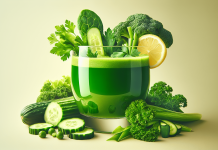Looking to curb those high blood pressure levels? Look no further! In this article, we have gathered a collection of tantalizing juice recipes that are not only delicious but also anti-hypertensive. From the refreshing combination of cucumber and mint to the tangy punch of citrus and ginger, these recipes are designed to support your journey towards a healthier blood pressure. So, grab your juicer and get ready to indulge in a glass of goodness that not only satisfies your taste buds but also promotes a healthier heart. Get ready to sip your way to better health!
Review contents
The Importance of Managing Hypertension and Blood Pressure
Hypertension, commonly known as high blood pressure, is a prevalent health condition that affects millions of people worldwide. It is vital to understand the significance of managing hypertension and blood pressure to maintain optimal health and prevent serious complications. By adopting a healthy lifestyle and incorporating nutritious foods into our diet, we can effectively manage blood pressure levels and reduce the risk of heart disease, stroke, and other related conditions. In this article, we will explore the effects of high blood pressure, the benefits of managing it, and discuss the nutritional components that are effective in maintaining healthy blood pressure levels.
Understanding Hypertension
Hypertension occurs when the force of blood against the walls of the arteries is consistently too high. This condition can be classified into two categories: primary (essential) hypertension and secondary hypertension. Primary hypertension is the most common type and develops over time with no identifiable cause. Secondary hypertension, on the other hand, is caused by an underlying condition such as kidney problems, hormonal disorders, or certain medications.
If left untreated, hypertension can lead to severe health complications, including heart attack, stroke, heart failure, and kidney disease. The importance of managing high blood pressure cannot be overstated, as it is a significant risk factor for cardiovascular diseases.
Effects of High Blood Pressure
High blood pressure exerts immense strain on the blood vessels throughout the body. Over time, this additional force can cause damage to the arteries and lead to atherosclerosis, a condition where cholesterol and other substances build up in the arteries, forming plaques. These plaques can restrict blood flow and increase the risk of heart attack or stroke.
Additionally, hypertension can cause damage to vital organs such as the heart, brain, and kidneys. It can contribute to the development of coronary artery disease, heart failure, and kidney failure. High blood pressure can also damage the blood vessels in the eyes, leading to vision impairment or even blindness.
Benefits of Managing Blood Pressure
Managing blood pressure is crucial for maintaining overall health and reducing the risk of associated complications. By effectively managing hypertension, we can:
-
Reduce the risk of heart disease and stroke: By keeping blood pressure within a healthy range, we minimize the strain on the heart and blood vessels, reducing the risk of heart disease and stroke.
-
Preserve kidney function: High blood pressure can damage the kidneys and impair their ability to filter waste products from the body. Managing blood pressure helps preserve kidney function and reduces the risk of kidney disease.
-
Prevent vision problems: Hypertension can damage the blood vessels in the eyes, leading to vision problems or even blindness. By managing blood pressure, we can protect our eyesight.
-
Maintain cognitive function: Chronic high blood pressure has been linked to cognitive decline and an increased risk of dementia. Managing blood pressure can help maintain cognitive function and reduce the risk of these conditions.
-
Improve overall well-being: By managing blood pressure and reducing the risk of associated complications, we can enhance our overall well-being and quality of life.
Incorporating lifestyle changes, such as adopting a healthy diet and regular exercise, along with proper medical management, can play a significant role in effectively managing blood pressure.
Nutritional Components Effective for Blood Pressure
While medications prescribed by healthcare professionals are essential for managing hypertension, incorporating specific nutritional components into our diet can further enhance the effects. The following nutrients have been found to be effective in maintaining healthy blood pressure levels:
Potassium
Potassium is an essential mineral that plays a key role in regulating blood pressure. It helps relax the walls of blood vessels, allowing for better blood flow and reducing the strain on the cardiovascular system. Foods rich in potassium include bananas, avocados, spinach, sweet potatoes, and beans.
Magnesium
Magnesium is another crucial mineral that supports healthy blood pressure levels. It helps relax and widen blood vessels, improving blood flow. Good sources of magnesium include dark leafy greens, nuts and seeds, whole grains, and legumes.
Calcium
Calcium is not only important for healthy bones and teeth, but it also plays a role in maintaining normal blood pressure. Adequate calcium intake helps with the dilation and constriction of blood vessels. Low-fat dairy products, fortified plant-based milk, tofu, and dark leafy greens are excellent sources of calcium.
Antioxidants
Antioxidants, such as vitamins C and E, help protect blood vessels from damage caused by oxidative stress. They also promote the production of nitric oxide, which helps relax blood vessels and improve blood flow. Berries, citrus fruits, leafy greens, and nuts are rich in antioxidants.
Fiber
Including fiber-rich foods in our diet can aid in maintaining healthy blood pressure levels. Fiber helps regulate blood sugar, cholesterol levels, and promotes a healthy weight, all of which contribute to maintaining optimal blood pressure. Whole grains, fruits, vegetables, legumes, and nuts are excellent sources of dietary fiber.
By incorporating these nutritional components into our diet, we can support our blood pressure management efforts and improve overall cardiovascular health.
Choosing the Right Fruits and Vegetables for Juicing
Juicing can be a convenient and enjoyable way to incorporate a variety of fruits and vegetables into our diet. Certain fruits and vegetables are particularly beneficial for managing hypertension due to their specific nutrient content. Let’s explore some options categorized by their nutritional components:
Low Sodium Options
Reducing sodium intake is crucial for managing blood pressure. Opting for low-sodium fruits and vegetables can help maintain healthy blood pressure levels. Some examples of low-sodium options include cucumbers, celery, watermelon, and strawberries.
High Potassium Options
As mentioned earlier, potassium plays a vital role in regulating blood pressure. Including high-potassium fruits and vegetables in our juice recipes can help boost our potassium intake. Bananas, oranges, spinach, and tomatoes are excellent sources of potassium.
Rich in Magnesium Options
To support healthy blood pressure levels, it’s beneficial to include fruits and vegetables rich in magnesium in our juices. Incorporating ingredients such as spinach, kale, Swiss chard, and almonds can provide a good dose of magnesium.
Packed with Calcium Options
Calcium is another essential nutrient for blood pressure management. Juicing calcium-rich fruits and vegetables can contribute to our daily calcium intake. Examples of calcium-packed ingredients include broccoli, kale, oranges, and figs.
Anti-Inflammatory Options
Chronic inflammation can contribute to the development of hypertension and other cardiovascular conditions. Including anti-inflammatory fruits and vegetables in our juices can help reduce inflammation and support blood pressure management. Turmeric, ginger, blueberries, and leafy greens are known for their anti-inflammatory properties.
By selecting the right fruits and vegetables for juicing, we can create delicious and nutritious blends that specifically target blood pressure management.
Juice Recipes for Lowering Hypertension
The following juice recipes are designed to help lower hypertension and maintain healthy blood pressure levels. These recipes combine ingredients that are rich in nutrients beneficial for blood pressure management:
1. Citrus Blast
- 2 oranges
- 1 grapefruit
- 1 lemon
Juice all the citrus fruits together for a refreshing and tangy blend. Citrus fruits are packed with vitamin C and other antioxidants that help promote blood vessel health and reduce oxidative stress.
2. Beet Power
- 2 beets
- 2 carrots
- 1 apple
- 1-inch piece of ginger
Combine all the ingredients into a juicer and enjoy the earthy and sweet goodness. Beets are known for their high nitrate content, which helps improve blood flow and lower blood pressure.
3. Green Goodness
- 2 cups spinach
- 1 cucumber
- 2 stalks celery
- 1 green apple
- 1 small piece of ginger
Run all the ingredients through a juicer to create a vibrant green juice packed with nutrients. Spinach and celery are excellent sources of potassium and magnesium, essential for blood pressure management.
4. Berry Boost
- 1 cup strawberries
- 1 cup blueberries
- 1/2 cup raspberries
- 1 cup unsweetened almond milk
Blend all the ingredients together in a high-powered blender until smooth for a delightful berry-rich drink. Berries are known for their antioxidant properties, which help support heart health and maintain blood pressure levels.
5. Pineapple Paradise
- 2 cups fresh pineapple
- 1 orange
- 1-inch piece of ginger
Juice the pineapple, orange, and ginger together for a tropical and zesty juice. Pineapple contains an enzyme called bromelain, which has been suggested to help lower blood pressure.
By incorporating these juice recipes into our routine, we can enhance our efforts in managing hypertension and improving overall cardiovascular health.
Juice Recipes for Promoting Healthy Blood Pressure
In addition to managing hypertension, it is important to promote healthy blood pressure levels in individuals with normal or slightly elevated readings. The following juice recipes are designed to maintain optimal blood pressure:
1. Pomegranate Punch
- 1 cup pomegranate seeds
- 1 apple
- 1 cucumber
- 1-inch piece of ginger
Blend all the ingredients together for a sweet and tangy drink. Pomegranates are rich in antioxidants and have been shown to have beneficial effects on blood pressure.
2. Celery Sensation
- 4 stalks celery
- 1 pear
- 1 cucumber
- 1 lemon
Juice all the ingredients together for a refreshing and hydrating juice. Celery has natural diuretic properties and can help regulate blood pressure.
3. Carrot Cleanse
- 4 carrots
- 1 orange
- 1-inch piece of turmeric
Run all the ingredients through a juicer to create a bright orange juice. Carrots are packed with vitamins and minerals, including potassium, known for their positive effects on blood pressure.
4. Watermelon Wonder
- 2 cups fresh watermelon chunks
- 1 cup strawberries
- 1 lime
Blend all the ingredients together for a refreshing summer drink. Watermelon is not only hydrating but also contains an amino acid called citrulline, which helps relax blood vessels and promote healthy blood pressure.
5. Ginger Zest
- 1 cucumber
- 2 green apples
- 1-inch piece of ginger
Juice all the ingredients together for a zingy and invigorating juice. Ginger has been used for centuries to promote cardiovascular health and can help support blood pressure regulation.
Incorporating Additional Ingredients for Enhanced Effects
To further enhance the effects of the juices mentioned above, we can incorporate certain additional ingredients known for their positive impact on blood pressure:
Garlic
Garlic has been shown to have potential cardiovascular benefits, including the ability to lower blood pressure. Adding a clove or two of garlic to the juice recipes can provide additional support in managing hypertension.
Ginger
In addition to its zesty flavor, ginger has been associated with improved blood flow and reduced blood pressure. Including a small piece of ginger in the juices can further enhance their impact on blood pressure management.
Cinnamon
Cinnamon has been found to have blood pressure-lowering effects. Sprinkling a small amount of cinnamon powder into the juices can add a warm and comforting flavor while supporting healthy blood pressure levels.
Turmeric
Turmeric is well-known for its anti-inflammatory properties and has been studied for its potential benefits in managing hypertension. Adding a pinch of turmeric powder to the juices can provide an additional boost for blood pressure regulation.
Flaxseed
Flaxseed is rich in omega-3 fatty acids, fiber, and lignans, all of which contribute to heart health and blood pressure management. Including ground flaxseed in the juice recipes can provide added nutritional benefits.
By incorporating these additional ingredients, we can further enhance the effects of the juices and promote optimal blood pressure levels.
Tips for Preparing and Juicing
Preparing and juicing fruits and vegetables can be a fun and rewarding experience. Here are some tips to ensure we make the most of our ingredients and enjoy the juicing process:
Choosing Fresh and Organic Produce
Selecting fresh and organic produce is crucial to ensure the juicing experience is both nutritious and safe. Look for fruits and vegetables that are firm, free from blemishes, and have vibrant colors. Organic produce is free from harmful pesticides and is a healthier choice.
Proper Cleaning and Preparation
Washing fruits and vegetables before juicing is essential to remove any dirt, bacteria, or pesticides present on the surface. Use cool running water and a gentle scrub brush to clean the produce thoroughly. Remove any stems, seeds, or tough skin before juicing.
Juicing Techniques and Equipment
Investing in a quality juicer or blender can make the juicing process more efficient and enjoyable. Learn the proper techniques for each machine and properly assemble and disassemble the various parts. Follow the manufacturer’s instructions for optimal usage.
Combining Ingredients for Optimal Health Benefits
Experimenting with different fruit and vegetable combinations can be a great way to discover new and delicious flavors. When combining ingredients, consider their individual nutritional profiles and aim to create a balanced blend that provides a variety of nutrients beneficial for blood pressure management.
By following these tips, we can ensure our juicing experience is not only enjoyable but also maximizes the nutritional benefits of the fruits and vegetables we use.
Considerations and Precautions
While juicing can be a healthy addition to a balanced diet, it is important to keep certain considerations and precautions in mind, especially when managing hypertension or any other medical condition:
Consulting with a Healthcare Professional
Before making any significant changes to our diet or lifestyle, it is advisable to consult with a healthcare professional, especially if we have pre-existing medical conditions or are on medication. They can provide personalized advice and guidance tailored to our specific health needs.
Monitoring Blood Pressure
Regular monitoring of blood pressure is essential, particularly when managing hypertension. Keeping track of blood pressure readings can help determine the effectiveness of lifestyle modifications, including the incorporation of juices, and guide further management strategies.
Possible Interactions with Medications
Certain ingredients used in juicing, such as grapefruit, may interact with certain medications and affect their effectiveness. It is important to be aware of potential interactions and consult with a healthcare professional or pharmacist if we are taking any medications.
Allergic Reactions
Individuals with known allergies or sensitivities to specific fruits or vegetables should exercise caution when incorporating them into their juices. It is advisable to start with small amounts and monitor for any adverse reactions.
By considering these precautions and seeking professional advice, we can safely incorporate juices into our lifestyle for optimal health benefits.
Incorporating Juices into a Balanced Diet
While juices can be a valuable addition to our diet, it is essential to incorporate them into a balanced and varied eating plan. Here are some tips to ensure we achieve a well-rounded diet:
Keeping a Variety of Fruits and Vegetables
In addition to juicing, aim to include a variety of whole fruits and vegetables in our diet. Eating whole fruits and vegetables provides additional fiber and other important nutrients that may be lost during the juicing process.
Portion Control
While juices can be nutritious, they can also be calorie-dense, especially when ingredients with higher sugar content are used. Use portion control to enjoy juices as a part of a balanced diet and prevent excessive calorie intake.
Balancing Nutritional Needs
Incorporating juices should not replace other important food groups or macronutrients in our diet. Ensure a balance of carbohydrates, proteins, and fats are included in our meals to meet our nutritional needs.
Lifestyle Changes
Managing blood pressure effectively extends beyond just incorporating juices into our diet. Adopting a healthy lifestyle that includes regular exercise, stress management, and avoiding tobacco and excessive alcohol use is essential for maintaining optimal blood pressure levels.
By incorporating juices as part of a balanced diet and making overall lifestyle changes, we can support our blood pressure management goals and improve our overall well-being.
Conclusion
Managing hypertension and maintaining healthy blood pressure levels is essential for promoting overall health and reducing the risk of cardiovascular complications. Incorporating specific nutritional components into our diet, such as potassium, magnesium, calcium, antioxidants, and fiber, can be effective in supporting blood pressure management. Juicing fruits and vegetables that are low in sodium, high in potassium, rich in magnesium and calcium, and possess anti-inflammatory properties can be a convenient and enjoyable way to incorporate these nutrients into our diet. By following the provided juice recipes and incorporating additional ingredients such as garlic, ginger, cinnamon, turmeric, and flaxseed, we can enhance the benefits of our juices. It is important to consult with a healthcare professional, monitor blood pressure, and consider precautions when incorporating juices into our lifestyle. By combining juicing with a balanced diet, lifestyle changes, and professional guidance, we can effectively manage hypertension and promote healthy blood pressure levels for optimal well-being.
































